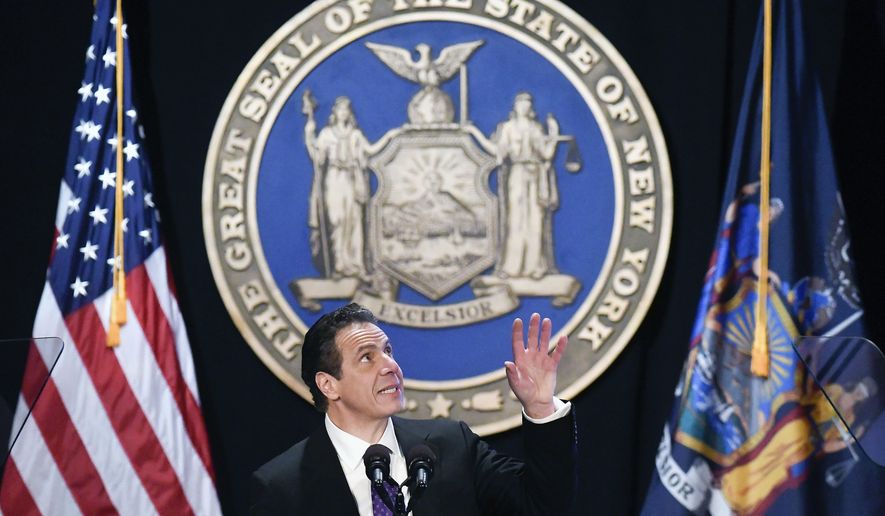Democrats in high-tax blue states are already plotting ways to avoid the new tax law, hoping to seize on gimmicks that will allow their residents to cut their federal tax burden without costing the states themselves any money.
The Democrats are trying to get around a new $10,000 cap on how much of their state and local taxes residents can write off on their federal forms. High-tax states fear their residents will quickly top the $10,000 limit, leaving them grumbling over their higher tax bills.
New York Gov. Andrew Cuomo has suggested switching some of his state’s tax collections from personal income to a corporate payroll tax, saying those aren’t subject to the $10,000 cap.
New Jersey and California Democrats, meanwhile, suggested allowing residents to pay some of their state taxes as charitable deductions, saying they could then claim the federal tax deduction for money they’re paying to the state.
“I think we need to do everything humanly possible to cut taxes and find ways to [give] people relief in the face of this tax hike bill, which … is directly targeted at states like ours,” Rep. Josh Gottheimer, New Jersey Democrat, said this week on MSNBC.
Mr. Gottheimer is helping spearhead the effort in New Jersey along with Democratic Gov.-elect Phil Murphy, who has also raised the prospect of challenging the new law in court.
SEE ALSO: Donald Trump hails tax-cut bonuses for workers, predicts more to come
In California, state Sen. Kevin de León has formally introduced legislation that would allow taxpayers to make a charitable donation to a state-run fund that they could, in turn, deduct from their own tax liability, minimizing the loss from the new limit on the so-called SALT deduction.
“The Republican tax plan gives corporations and hedge-fund managers a trillion-dollar tax cut and expects California taxpayers to foot the bill,” said Mr. de León, who is also running for U.S. Senate this year. “We won’t allow California residents to be the casualty of this disastrous tax scheme.”
High-tax states were a major point of contention during last year’s debate, costing the government $1.3 trillion in lost revenue over a decade. Republicans eyed that cash, saying it would be better used lowering tax rates for everyone.
It didn’t hurt that the old system benefited taxpayers in mostly Democratic-led high-tax states, and many conservatives hoped that by eliminating the breaks those states could be forced to cut their taxes.
In the end, Congress struck a compromise, putting a cap on the deduction so only higher-income people would lose out.
That still isn’t good enough for the highest-tax states, though, and lawmakers are looking for ways around it.
Mr. Cuomo used his State of the State speech in New York this year to float the idea of shifting some of the state’s individual income tax burden to an employer-based payroll tax.
“It is complicated, it is difficult, but it is clear that we must protect New York taxpayers from this assault,” Mr. Cuomo said. He also said they would explore the charitable donation angle California and New Jersey are pursuing.
Tax experts say that while novel, the ideas might not pass legal or political muster, as they would be treading completely new ground in federal tax law.
For example, workers in New York could be forced to stomach lower wages in order to ensure that companies and state coffers don’t take too much of a hit under the new payroll tax scheme, said Jared Walczak, a senior policy analyst at the Tax Foundation.
He also said if employers are seen as effectively paying individuals’ income taxes for them, it wouldn’t be a deductible benefit and the IRS would likely step in.
Mr. Walczak also called the charitable giving idea an “ingenious scheme” but one “likely to fail.”
“This is unlikely to be perceived as an actual charitable contribution and, rather, as simply a tax avoidance scheme,” he said. “It is highly unlikely that the IRS would allow that deduction to be taken.”
But Matthew Gardner, a senior fellow at the Institute on Taxation and Economic Policy said the ideas could ultimately work depending on how they’re structured.
“Both of them, in theory, could achieve the goal that these guys want to achieve, which is to hold people harmless on the federal side,” he said.
“I guess the main issue is just one of implementation and, to a lesser extent, I guess of fairness,” he said.
He compared the charitable giving idea to a provision in the current code that allows for tax-deductible contributions to certain private or charter schools.
“From a practical perspective, there’s no reason you couldn’t implement that,” Mr. Gardner said of the California proposal.
Mr. Cuomo said he plans to challenge the broader law as an unconstitutional infringement on states’ rights and equal protection, and Mr. Murphy in New Jersey has hinted at possible legal challenges as well.
“It’s hard to find an example in recent memory of a tax provision that so clearly disadvantages some states relative to others,” Mr. Gardner said.
But Mr. Walczak said many federal policies vary between the states, such as social welfare programs that depend on the size and composition of states’ low-income populations.
“Almost any federal law is going to have varying impacts based on population and demographics and any number of things,” he said.
• David Sherfinski can be reached at dsherfinski@washingtontimes.com.




Please read our comment policy before commenting.